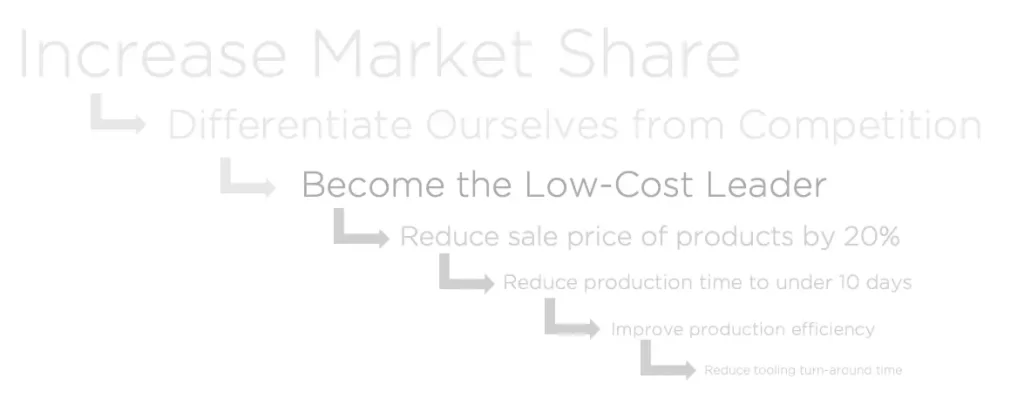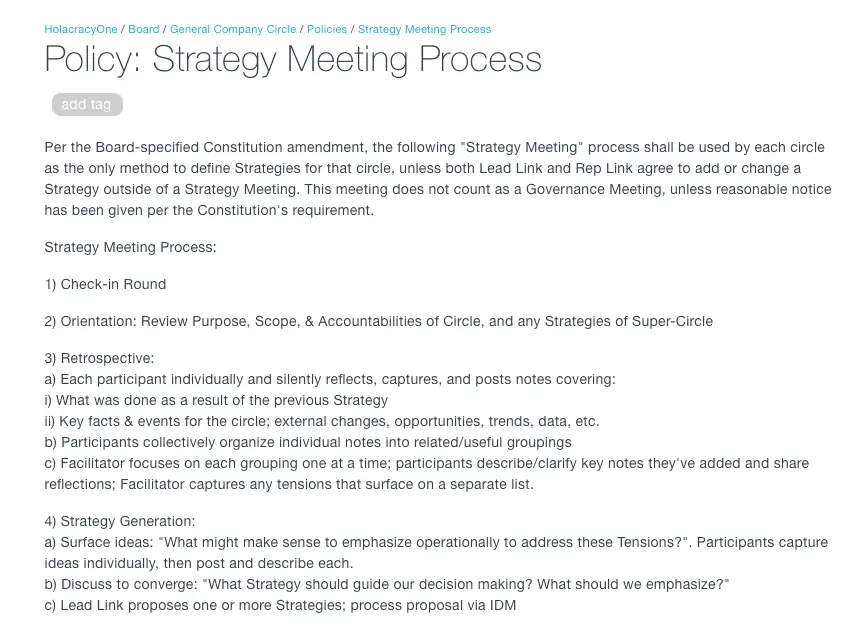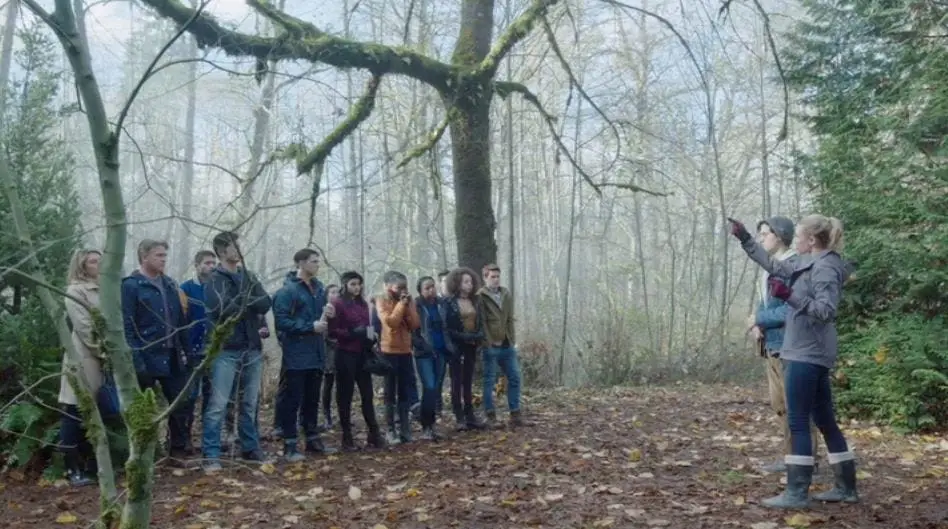Holacracy Basics: Understanding Strategies
In order to understand Holacracy, sometimes we have to revisit things we already know.
In order to understand Holacracy, sometimes we have to revisit things we already know.

A Circle’s Lead Link may define relative priorities for the Circle. In addition, the Lead Link may define a more general “Strategy” for the Circle, or multiple Strategies, which are heuristics that guide the Circle’s Roles in self-identifying priorities on an ongoing basis. (Section 2.2.2)
In order to understand Holacracy, sometimes we have to revisit things we already know. Things, which upon closer inspection, aren’t as obvious or as simple as they first seem. Strategies are a perfect example.
We all know strategies help us solve problems. We look at a situation, figure out what’s needed, then execute. So, if you’re lost in the woods, a good strategy will help you get out.
But “strategy” has a specific definition in Holacracy as a “heuristic” or “rule-of-thumb” (e.g. “Look before you leap”) which enables a person to prioritize their own work.
For example, a strategy like, “Innovate new products & test the market even over optimizing the status quo,” tells me to prioritize developing new products over improving old ones.
And if a maxim like, “Look before you leap,” doesn’t resonate with how you normally think of a strategy, you’re not alone. It didn’t make sense to me either. But as I’ve practiced and reflected, I’ve come up with a few distinctions which may help.
None of the twelve organizations I researched (all of which are remarkably successful) has a strategic document, a strategic plan for the next three or five years.
Frederic Laloux, Reinventing Organizations
The way we normally think of a strategy is something like, “A plan designed to achieve a major or overall goal.” The idea is that we need to get everyone on the same page and heading toward the same goal. We may even keep track of how we’re doing, breaking that overall goal down into smaller milestones to achieve. And while planning can work perfectly fine, there’s a problem: things rarely go according to plan.
The management hierarchy emerged precisely because workers needed to be coordinated. The fuel of the industrial revolution was consistency and efficiency, so you couldn’t have front-line factory workers making localized decisions. No. You needed a good plan and workers who would follow it.
Everyone has a plan until they get punched in the mouth.
Mike Tyson
But with machines doing more and more physical and repetitive work, and people doing increasingly complex problem-solving, strategic planning can’t keep up. Things just change too rapidly. We simply can’t effectively predict, and then plan for, what’s going to happen.
The other problem with defining strategies as “A plan designed to achieve a major or overall goal” is it quickly becomes confusing; what is a goal…and what is a way to achieve the goal? Let’s look at this conventional business “strategy” as an example…

Does this statement define a goal or a way to get to a goal? Well, technically, it defines a goal. But what about if you were in the company and you knew that, “Become the Low-Cost Leader,” was actually a part of a larger goal called, “Increase Market Share.”

Seen this way, “Become the Low-Cost Leader,” meets the definition of a strategy because it’s a way to achieve the overall goal of “Increase Market Share.” And if that’s confusing, I think so too.
Yet, this is essentially how conventional organizations operationalize strategy. “Strategy” becomes synonymous with “strategic plan”, and how to achieve the goal becomes nothing more than a list of cascading milestones. And that’s what’s missing from the conventional way of defining a strategy; it gives us a series of whats but never really a how.

Now, having clearly defined goals is important. Very important. So, we needn’t throw the baby out with the bathwater here, but in Holacracy terms, these cascading goals might be more accurately captured as “Projects” (read more here), or even as the “Purpose” of a role or circle.
But defining strategy only in terms of a plan with specific milestones misses something.
Milestones or sub-goals feel strategic because they tell us what information to pay attention to. In other words, they help us prioritize. For example, imagine you’re wrestling with the question, “Should I optimize this product feature, or drop it completely to reduce production cost?” Well, if the strategy is, “Become the Low-Cost Leader,” then I know to prioritize reducing costs.
But if what we want is prioritization, then there is another way to get there. And this is where heuristics come in. Because detailed strategic plans are great if we trust them, but rapid change often means our maps are obsolete as soon as we draw them.
But if maps won’t always work, what about a compass? A compass can help you get out of the woods just as well as a map. And that’s exactly how heuristics work. Rather than defining a series of destinations, they help you orient moment-to-moment. They provide direction.

With a self-organizing practice like Holacracy, we need a way for people to make informed decisions on new and unexpected issues. For example, imagine a customer requests an exception to your 60-day return policy. You have the full authority to grant it. What do you do?
Well, if you have a strategy like supporting customers above consistency, then you’ll give the exception. On the other hand, if you’ve been dealing with chaotic bookkeeping, and customers complain your policies are already inconsistently applied, then you won’t.
Heuristics are simply rules-of-thumb which reduce the cognitive load of making a decision. They act almost like principles or values (more on that later).
Sayings like “He who hesitates is lost,” “Let sleeping dogs lie,” and “The squeaky wheel gets the grease,” provide general guidance. How and when you apply it is up to you.
Rather than try to predict and force a particular future, heuristic-strategies allow us to find where the organization wants to go. Meaning, we’re shifting from predict-and-control to sense-and-respond.
Think of how you ride a bike. Before you set off, do you figure out the precise steering angle you’ll need in each moment given the uneven terrain? No. You just go. And make thousands of micro-adjustments along the way.

Strategies in Holacracy are designed to work the same way. They should give you some way to orient yourself to your surroundings. That is, they aren’t anti-planning, they are just helpful ways to orient you when you hit the inevitable bumps in the road.
For example, if you wanted to ride your bike along the coast of Ireland, you’d probably do a fair amount of planning upfront. What supplies to take. What to leave behind. Maybe even which specific routes to take. Great. But what happens when one of those roads is closed? Do you take the shorter route that gets you there more quickly or the more scenic route that might make it more memorable? Well, it depends on your strategy.
Another way to think of a strategy is to consider how sports teams often have distinctive styles of play. Even though every national soccer team obeys the same rules and has the same goal (i.e. win the game), they can differ wildly on how they get there. For example…
Note: These descriptions may not reflect reality; frankly, I have no idea. I got the details from this website just to illustrate the similarity to Holacracy’s definition of strategy. It’s just an analogy.
These different styles of play, if consciously defined, also meet the definition of a strategy in Holacracy. Again, they don’t tell you the destination, or where to go, but how to get there.
And since the team needs to be rowing in the same direction even while strategies can be updated based on changing conditions, it’s important to make these stylistic choices transparent. Given everything we know right now, should we play conservatively or fast-and-loose? The Lead Link should pick one and know that they can adapt whenever new information surfaces.
From my experience, the best way to define a strategy is whatever way works best for you. And my point is that no matter what others tell you (or even my own suggestions below), you can always rely on your own interpretation of the constitution included at the beginning. With that said, here are my suggestions.
The best strategies not only tell you what to do, but also what not to do. For example, while a strategy like “Delight Customers” tells me something, it’s still not very helpful. Because it’s not like I might accidentally think, “I should piss off customers.” No, and the whole point is to help me make tough decisions. Deciding between a good thing and a bad thing is easy (e.g. “Cake or death?”). But what do I do when both choices seem good? Ah! That’s when a strategy helps. Here is what I mean…
In all of these examples, a hard choice has already been made, which means I don’t have to think as much on-the-fly. This is why celebrated consultant and Harvard Business School professor Michael Porter said, “The essence of strategy is choosing what not to do.”
Note: I encourage you to poke around HolacracyOne’s GlassFrog® records and look at example strategies.
Now, deciding between two good options is hard. This is why I recommend using a specific process, designed for surfacing information from lots of different perspectives. In fact, in HolacracyOne we have a policy that limits Lead Links to using a process that does just that (you can read the whole process here).

But two important caveats to this. First, I wouldn’t recommend making this a requirement in your organization (i.e. a governance policy). At least, not at first. I’m showing this policy as an example because the descriptions of the specific steps, e.g. “Orientation,” and “Retrospective,” may be helpful if you don’t know where to begin.
Second, the process isn’t to get consensus on the strategy. It’s still very clearly about helping the Lead Link decide on the strategy. Even in our case in which the Lead Link is required to follow this process, it’s still a Lead Link decision.
Using any structured process should help you generate compelling strategies, but again, I wouldn’t throw stones at a strategy like, “Improve product efficiency.” If it’s good enough for now, great!
Why does everybody know “Look before you leap” and “A bird in the hand is worth two in the bush?” Because they’re sticky. They’re more likely to pop into your head at the right moment. This is where a strategy like “Provide good customer service” really falls short. It doesn’t have any juice.
With that said, it doesn’t matter why a strategy is memorable, so long as it is. In HolacracyOne’s Training Circle we have a strategy, “Trainings not dependent on Brian.” It’s not contrasting two positives, but for us, it’s compelling and easy to remember. This is another advantage of using a group process to define strategies — by doing it in real-time, it gives a Lead Link insight into a strategy’s stickiness.
Before I go, let me say something about bad strategies. Now, in general, strategies have a low basement and a low ceiling. Meaning, it’s easy to get ones that are good enough, and it’s usually not worth a lot of extra effort to make a good one even better.
That’s how heuristics work. They are meant to be practical without making any promise of being optimal. With that said, I’ve seen a few ways strategies can go wrong. So, consider these a heads up.
Using strategies to set targets and tying someone’s compensation to hitting those targets is a misuse of strategy. Even if it works, it’s a bad idea. Do you want people working on the most important thing, or what pays them the most? Those might not be the same thing.
“Become the low-cost leader in two years,” is a bad strategy. Things will likely change before then and, worse, it may even set an unintentional limitation to potential innovations that could be implemented right now. If something needs to be done quickly, something like “Cut costs quickly even over sustainable improvements,” is better.
Don’t assume statements about “Company Values” are a good substitute for a strategy. While there’s nothing wrong with using them descriptively (i.e. describing how things are to highlight any polarity imbalances), they don’t work great when used prescriptively (i.e. as guides to behavior). If you’re interested, you can read all about that here.
With distributed authority, we need a way to coordinate our action that doesn’t rely on someone figuring everything out from above, then telling everyone on the front lines what they should be doing.
All a strategy does, regardless of how you define it, is to help people prioritize for themselves. Remember the official definition states strategies are heuristics “…that guide the Circle’s Roles in self-identifying priorities on an ongoing basis (Section 2.2.2).”
I like to imagine it’s as if a large search party gathered on the edge of a forest. Everyone needs the freedom to go their own way, but they also need to find each other on the other side.

The coordinator is like the Lead Link and when they define a strategy, they aren’t giving marching orders, they’re just handing everyone a compass.
And if Holacracy’s way of defining “strategy” still feels like it’s missing something, don’t forget that this is only one of many tools available to get alignment. You can use governance to define purpose, expectations, and restrictions, and you can request projects and projections to keep tabs on what’s happening operationally.
So, “strategy” is just one piece of the larger puzzle. So if you’re brand new to Holacracy practice, or you’ve wrestled with understanding strategies as I did, I hope this article made your way through the woods is a little clearer.
Read “Introducing the Holacracy Practitioner’s Guide” to find more articles.
To learn more about self-management, join a community of pioneers and check out our e-courses → Self-Management Accelerator
